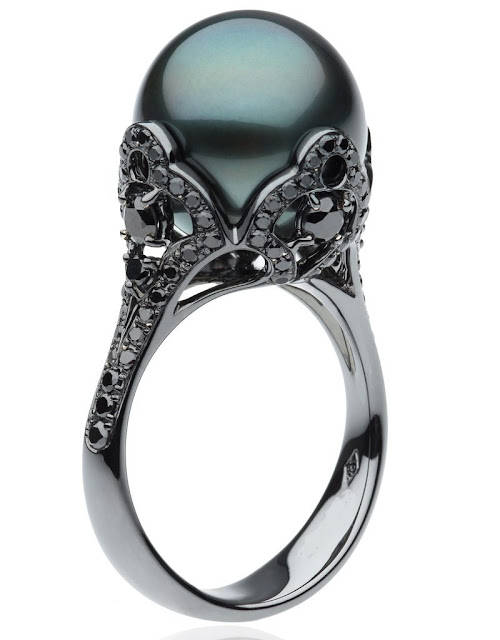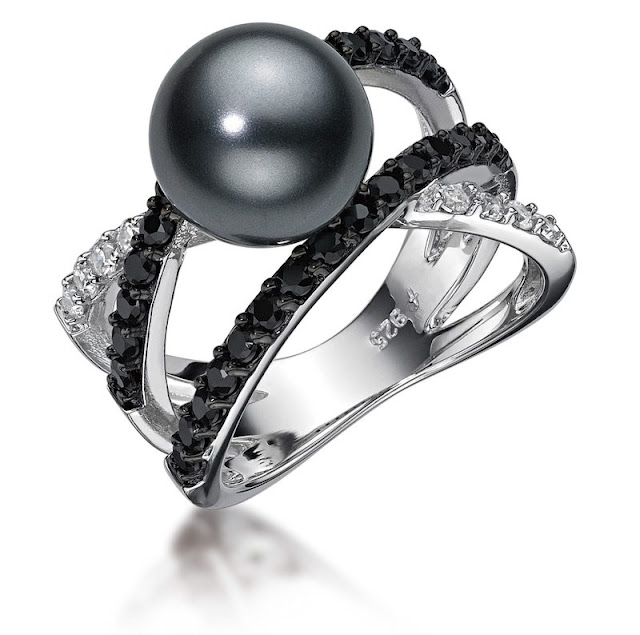Probably the most famous and coveted of all pearls are the black pearls. They are cultured from the oyster Pinctada Margaritifera, the black lipped oyster, from which they get their name. The black pearl is found in the South Sea ocean surrounding French Polynesia (Tahiti) and The Cook Islands. These pearls typically range in size from 7mm to 15mm but can be as large as 20mm (though these pearls are very rare).

Black pearls are not black at all but come in a variety of colors. A true "black" black pearl is a rarity since even the black colors have varying shades of grey, blue, purple, green, and rose. The body color is always enriched by at least one other overtone and many undertones.

Body colors are black, blue, grey, green, and brown. Overtone colors consist of pink, blue, gold, red, grey, and reddish-purple. When these overtones present in a variety of combinations along with the body color, they produce a truly expensive pearl called a fancy color black pearl. The following is a partial list and definition of those colors:
Through most of the seventies and early eighties, black pearls where relatively unknown by the common person. That changed in the mid eighties when Elizabeth Taylor began a perfume campaign extolling the perfume's exclusivity by associating it with the black pearl.

This catapulted the black pearl to fame among the average individual. Suddenly, these pearls became very popular and pearl farmers struggled to keep up with demand.

However, by the late 1990's the market started to get saturated with black pearls as the grafting process began to be perfected and many Tahitians and investors turned to pearl farming. A significant quantity of these pearls were considered poor quality and the cost of the black pearl began to go down.
In 1993, the French Polynesia Assembly decreed the formation of the Groupement d'Interet Economique Perles de Tahiti (GIE PdT), aka Perles de Tahiti, to promote and protect the black pearl as well as advance the economic interests of the French Polynesian government, trade professionals, and the consumer. This organization initially played a minor role in the global economics of the black pearl. But, by the end of the 1990's, the market saturation of the black pearl had reduced prices to their lowest level ever and the French Polynesia Assembly turned over full regulatory control of the black pearl to this agency.

Since then, all black pearls that are meant for sale that will take the pearl out of French Polynesia must be submitted to Perles de Tahiti for evaluation. Any pearls not meeting the minimal criteria for exportation are destroyed. All other pearls are then graded and sold at nine auctions that occur throughout the year; five in Hong Kong between Robert Wan Perles Tahiti and Poe Rava Nui and two in Kobe, Japan. Pearl farmers who have private contracts with vendors must still submit for evaluation and obtain certification prior to exportation.

When searching to buy black pearls, make sure you deal with a reputable vendor. Easier said than done for most of us. What should you look for in a reputable vendor? Anyone dealing in genuine black pearls will be more than happy to guarantee their pearls to be cultured black pearls of natural color. This can be done in several ways but the most common is either through GIA certification or a warranted appraisal performed by an independent, registered appraiser. Realize you may have to pay an extra charge for either of these services and GIA verification takes 10-15 business days, but it will verify that you have bought an authentic black pearl and give you peace of mind.

Beware of vendors claiming to sell Tahitian Black Akoya pearls (which would require one pearl being produced from two different types of oysters) and Tahitian Black Shell Pearls (which are actually manufactured pearls made from the shell of the black lipped oyster). Also be leary of anyone who claims to deal directly with the pearl farmer. If this is true, they will be able to provide certification from Perles de Tahiti that their lot was submitted for examination, graded, and passed the agency's criteria for exportation.
Finally, be careful of Chinese vendors claiming to sell or farm black pearls; many of these pearls are enhanced, freshwater, or faux pearls since the oceans around China are not conducive to farming the black lipped oyster.

I hope this guide has helped educate you about the beautiful black pearl. If it has, please vote yes. As always, if you have anything to add or can offer some constructive criticism, contact me via comment form. Aloha and ahui hou!

Black pearls are not black at all but come in a variety of colors. A true "black" black pearl is a rarity since even the black colors have varying shades of grey, blue, purple, green, and rose. The body color is always enriched by at least one other overtone and many undertones.

Body colors are black, blue, grey, green, and brown. Overtone colors consist of pink, blue, gold, red, grey, and reddish-purple. When these overtones present in a variety of combinations along with the body color, they produce a truly expensive pearl called a fancy color black pearl. The following is a partial list and definition of those colors:
- Peacock pearl: green, blue, purple overtones with a black body.
- Aubergine pearl: purple and red with a black body.
- Champagne pearl: gold with a grey body.
- Lavender pearl: blue, red, grey with a grey body.
- Pistachio pearl: green, grey with a grey body.
- Oil slick pearl: green, blue, gold, grey with a black body.
Through most of the seventies and early eighties, black pearls where relatively unknown by the common person. That changed in the mid eighties when Elizabeth Taylor began a perfume campaign extolling the perfume's exclusivity by associating it with the black pearl.

This catapulted the black pearl to fame among the average individual. Suddenly, these pearls became very popular and pearl farmers struggled to keep up with demand.

However, by the late 1990's the market started to get saturated with black pearls as the grafting process began to be perfected and many Tahitians and investors turned to pearl farming. A significant quantity of these pearls were considered poor quality and the cost of the black pearl began to go down.
In 1993, the French Polynesia Assembly decreed the formation of the Groupement d'Interet Economique Perles de Tahiti (GIE PdT), aka Perles de Tahiti, to promote and protect the black pearl as well as advance the economic interests of the French Polynesian government, trade professionals, and the consumer. This organization initially played a minor role in the global economics of the black pearl. But, by the end of the 1990's, the market saturation of the black pearl had reduced prices to their lowest level ever and the French Polynesia Assembly turned over full regulatory control of the black pearl to this agency.

Since then, all black pearls that are meant for sale that will take the pearl out of French Polynesia must be submitted to Perles de Tahiti for evaluation. Any pearls not meeting the minimal criteria for exportation are destroyed. All other pearls are then graded and sold at nine auctions that occur throughout the year; five in Hong Kong between Robert Wan Perles Tahiti and Poe Rava Nui and two in Kobe, Japan. Pearl farmers who have private contracts with vendors must still submit for evaluation and obtain certification prior to exportation.

When searching to buy black pearls, make sure you deal with a reputable vendor. Easier said than done for most of us. What should you look for in a reputable vendor? Anyone dealing in genuine black pearls will be more than happy to guarantee their pearls to be cultured black pearls of natural color. This can be done in several ways but the most common is either through GIA certification or a warranted appraisal performed by an independent, registered appraiser. Realize you may have to pay an extra charge for either of these services and GIA verification takes 10-15 business days, but it will verify that you have bought an authentic black pearl and give you peace of mind.

Beware of vendors claiming to sell Tahitian Black Akoya pearls (which would require one pearl being produced from two different types of oysters) and Tahitian Black Shell Pearls (which are actually manufactured pearls made from the shell of the black lipped oyster). Also be leary of anyone who claims to deal directly with the pearl farmer. If this is true, they will be able to provide certification from Perles de Tahiti that their lot was submitted for examination, graded, and passed the agency's criteria for exportation.
Finally, be careful of Chinese vendors claiming to sell or farm black pearls; many of these pearls are enhanced, freshwater, or faux pearls since the oceans around China are not conducive to farming the black lipped oyster.

I hope this guide has helped educate you about the beautiful black pearl. If it has, please vote yes. As always, if you have anything to add or can offer some constructive criticism, contact me via comment form. Aloha and ahui hou!
Comments
Post a Comment